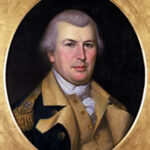On October 19, 1781, British General Charles Lord Cornwallis surrendered his 21,000 soldiers and sailors to a combined American and French force under the command of General George Washington, ending the revolutionary war and securing the independence of the United States. Today, the Yorktown Battlefield and the Yorktown Victory Center commemorate the site of the final major battle in America’s war for independence.
Anyone wishing to visit Yorktown should begin at the battlefield’s visitor’s center. The visitor’s center, which is managed by the National Park Service, offers maps and information for those interested in guiding themselves through the battlefield tour. Additionally, National Park Service Rangers are available for guided tours that provide in-depth descriptions of the battle and of the ramifications of the American victory. If you’re not interested in hiring a guide, an audio tour is available in the gift shop on either cassette or CD.
While at the visitor’s center, it is recommended that you watch the 15-minute film prior to beginning your tour. The film, called “The Siege of Yorktown,” is an excellent depiction of the battle with character dialogue and exciting battle re-enactments. After the film, be sure to check out the exhibits in the visitor’s center, especially the campaign table used by General Cornwallis at Yorktown. Finally, before heading out on your tour of the battlefield, take a trip to the roof of the visitor’s center and view the battlefield from the observation deck. The view is stunning and gives a unique perspective on the lay of the land around Yorktown.
When touring the battlefield, you will encounter original and reconstructed earthworks and siege lines from both British and American positions, as well as Surrender Field, a large open area where the British soldiers finally laid down their arms in surrender to the American Continental Army. Along the tour, be sure to stop at the Moore House, the site of the actual surrender negotiations, or Articles of Capitulation, as they were called then. Several rooms in the house have been refurbished and both upstairs and downstairs levels offer a glimpse at life in colonial America.
If time permits, there is a second driving tour available from the visitor’s center that takes you through the locations where the American and French soldiers set up their encampments, and where General Washington positioned his headquarters for the battle.
Near the battlefield is the Yorktown Victory Center, which houses a host of exhibits to educate visitors about colonial life and about the battle that secured American independence. The Victory Center, which is hailed as a museum of the American Revolution, is a combination of timeline, film, exhibits, and outdoor living history.
The exhibits inside the Center portray life in colonial America and feature multiple artifacts from the period and from the battle. Outside the Victory Center, a replica 18th century farm depicts rural life in eastern Virginia, complete with gardens, animals, a smokehouse, dwelling and separate kitchen. The farm offers visitors an intriguing glimpse into early American farm life.
Near the farm is perhaps the best exhibit on display at the Victory Center. The Continental Army encampment features artillery, musket, and military drill displays, as well as interpreters in period costume detailing the life of the ordinary soldier in revolutionary America.
Visitors can learn about period medical techniques and treatments, camp cooking, colonial clothing, and sleeping accommodations by checking out any of the displays available for touching and close examination. Kids can try on soldier uniforms and climb inside small tents, or relax in the army commander’s spacious tent while reading his maps or lying in his bed. The encampment is always a big hit and is always buzzing with activity. The characters are knowledgeable and friendly, and always stay true to their character.
In addition to the battlefield and the Victory Center, visitors can tour downtown Yorktown, first settled in 1691. The town features a vibrant waterfront that is chock full of stores and restaurants, as well as historical landmarks like the Nelson House, home of Thomas Nelson, Jr., a signer of the Declaration of Independence.
For young and old alike, Yorktown has something to offer. From learning about one of the most important battles in our nation’s history, to experiencing life in colonial America, to shopping and dining along a historic waterfront, Yorktown is a place you should consider for your next vacation.

